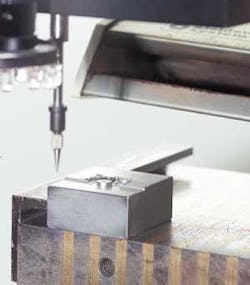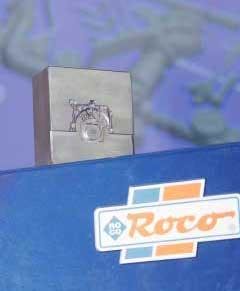Perfection to the last detail
Roco (Salzburg, Austria), founded in 1960 with humble resources and great vision, is among the youngest of the big producers of model train sets in Europe. The company has attained a leading position in the world market thanks to a special understanding of its customers, who are interested in details, and to its innovative ideas and inexpensive but attractive models.
In 1960 the economy was on the upswing and there was great confidence in the future. Television was still young. A new, unconventional kind of music—rock n' roll—was being heard. Man started to conquer space. And a comparatively new plastic material came into greater use. This material was the trigger for Heinz Roessler, the founder of Roco, who recognized the mood of the times. New plastic injection-molding technology was able to deliver a much finer detail than metal injection technology, and do it for less money.
A team of highly qualified specialists was put together at Roco, and soon plastic military models with unprecedented detail work were produced. The success of these models was enormous, especially in the U.S. market, where the demand was very high. It almost sounded like from a fairy tale when an American business partner wrote, "Ship as many as you can make..."
The production of American train models began only a few years after the company had begun with "Minitanks." First were the H0 and 0 gauge sizes. The N-gauge models followed in the mid-1960s, and in 1967 Roco brought the first H0 models to the European market.
Thus the foundation for further success at Roco was laid. Today, the company, with more than 800 employees, is one of the world's biggest producers of H0 and N scale model train sets. The Roco name is synonymous with finest details, accurate scale and the highest precision.
In order to deliver these high standards, appropriate injection molds are necessary. No wonder Roco has kept this technology as core competency within the company. Until two years ago, milling and electric discharge machining (EDM), together with a high volume of precision manual labor were the state of the art to form perfect pipelines, fittings, small rivets and other details used in engines and freight cars. Since then the processing chain that used many molding tools has been cut dramatically, thanks to the innovative laser technology of the DML 40, a laser milling machine from Lasertec (Pfronten, Germany), a division of Deckel Maho Gildemeister.
This system was developed by DMG for a process known in its early days as laser caving. Essentially, the process uses a focused laser beam in place of the cutting tool normally used in pocket milling machines. Controlled removal of discreet amounts, via vaporization, of material produces a finely machined precision cavity.
Manfred Bachmann, plant manager of Roco's tool makers shop, says, "Bigger cavitations are still mostly eroded. The high-speed milling of the electrodes has resulted in considerable savings potentials. But in comparison to lasered filigreed geometry elements, results have improved in a quantum jump." And, adds Bachmann, "Earlier high-precision templates were manufactured to a scale of 1:4. Their form was copied onto the work piece by tedious manual work, with the help of a copy machine. For very difficult contours, which even the smallest end mills could not cut, extra small electrodes had to be used. In contrast (with the laser system) we work virtually from the CAD system directly to the work piece now. This enables us to save more than 50 percent of manufacturing time and reduces the cost."
However, at the beginning of the decision-making process Roco engineers were skeptical, remembers Bachmann, "We were not very optimistic three years ago when our company had the idea of using laser technology for tool making. Even if the supplier's brochures promised a lot, the experts had their doubts about the feasibility of the process."
The doubt did not stop Roco from trying. The company's philosophy is "In order to progress you must transform your vision in reality." And the result was visible. It did not take long to realize the promised potential of laser technology.
"Suddenly we were full of vigor for the focused beam," is how Bachmann describes the change in mood that led to the installation of the laser machine from DMG now in the Roco tool shop. Their pioneer spirit was high and the serial number 4 on the machine housing is the best evidence of this. "We were the first in Austria," adds Bachmann proudly.
null
Now employees of the tool shop cannot imagine working without the DML 40. However, success was only achieved with Roco's own participation Bachmann adds. This is not a value judgment of the technology or the machine. "When you enter new technology terrain, neither you nor the machine supplier has any work experience to build upon. Therefore we had to work for many days and nights to optimize the process for our specific tasks. For example it was a challenge to configure the laser parameters so that the rivet heads produced were really semi-round."
After two years, the laser machine is used daily. A 3D CAD drawing and its STL file are converted into a CNC program for the DML 40 using the proprietary Laser Soft 3D-software. The work can begin after minimal optimization and setup routines.
The positioning of the work piece is achieved through three linear motion axes with digital servo drive. Laser machining is performed with the focused beam moved using two highly dynamic drives of deflection mirrors. The heart of the machine is a pulsed Nd:YAG laser from Trumpf (Schramburg, Germany) with an average power of 100 W. A Q-switch pulses the beam, which can reach top power up to 200 kW. The diameter of the laser beam at focus can be set between 0.04 mm and 0.1 mm.
Based on this positive experience, Bachmann is now considering an exchange of the existing DML 40 with a newer generation machine. Like Roco, Lasertec, as the supplier of the machine, has made progress in the last few years. This is apparent in the latest models of the new machines of the DML 40 series. The new models DML 40 S and DML 40Sl are a step into fully automatic laser machining, including the defined slants of vertical walls. These are precisely the features that Roco is interested in, because they will open new areas of application and create the potential for further usage.
For more information on laser milling and machining systems, contact Lasertec at Tel. +49 831 51241-18 or visit www.gildemeister.com.



